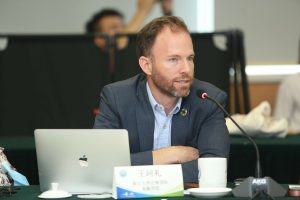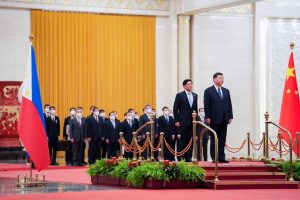Green China and Sustainable Asia in 2024
Written by Alex Somlyay
With ongoing developments in Chinese green energy technology, Australia is primed for further financial engagement and cooperation with the nation, said Dr. Christoph Nedopil Wang at an AIIA Queensland event.

Christoph Nedopil Wang, (image supplied)
His presentation reflected on the five trends dominating Chinese renewable energy technologies, alongside geopolitics and trade. Dr. Nedopil Wang, pictured, is a Professor of Economics at Griffith University and the Director of the Griffith Asia Institute. He has worked as a consultant and researcher for several entities, including the World Bank, and was a lead author of a UNDP report last year titled ‘(Re-)orienting Sovereign Debt to Support Nature in Asia Pacific’.
Throughout his speech, Dr. Nedopil Wang emphasised the success of Chinese green energy technologies, both domestically and abroad. This “Green Transition” was the first major trend, which saw China’s GDP grow by 5.3%. The vast majority of this growth was in green technologies, particularly the electric vehicles sector. In addition, China continues to lead in the solar industry, manufacturing up to 80% of all solar panels. Dr. Nedopil Wang noted that many Asian economies are turning towards greener energy solutions. China is then primed to secure billions of dollars in international deals, especially with countries including Indonesia, Pakistan, Uzbekistan, India, and Vietnam. This goes hand in hand with Chinese investment in these nation’s transport infrastructures, filling a “trillion-dollar gap” in Asian domestic industries.
The Belt and Road Initiative was a fitting segue here and became the second focus of the talk. China continues to accelerate its foreign trade and development programs. Fears of trade impositions, especially from the West, have driven moves to “derisk supply chains,” according to Dr. Nedopil Wang. This comes alongside increasing manufacturing costs and domestic overcapacities, spurring desire for foreign investment. Such decision-making will strongly impact the economic landscape in Asia.
The Belt and Road Initiative underpins China’s new global governance model, which Dr. Nedopil Wang examined next. In his view, China seeks to present itself as an alternative to Western development strategies, prioritising infrastructure over profit. China still sees itself as “the world’s largest developing economy,” and therefore an international role-model. Beyond Belt and Road, China plays a fundamental role in the AIIB, the SCO and BRICS organisation. Geographically, BRICS composed 27% of the world’s landmasses and 42% of its population, not accounting for new member states including Egypt, Ethiopia, Iran and the United Arab Emirates, who all joined on January 1 this year. Australia is not a member of any of these organisations, despite China’s desires for further international cooperation. Here, Chinese economic diplomacy mirrors concerns over its exclusion from the World Bank and UN. Dr. Nedopil Wang noted that Australia, like many other Western economies, is situated to provide the finances and skills necessary for collaboration. This engagement would be “essential” in order to sustain a green energy transition not just in Asia, but globally. Indeed, as green energy balloons to greater and greater market shares, refusal to engage would deprive the Australian economy of a massive international opportunity.

Chinese leader Xi Jinping hosts Philippine president Bongbong Marcos (Government of the Philippines)
Such a transition foregrounded his fourth point for international reproachment, with China’s desires for economic collaboration being tested against geopolitical and ideological disputes. This comes in the wake of Sino-Philippine naval standoffs in response to updated Chinese territorial demands. Other military engagements, particularly with China’s neighbour, India, represent unresolved concerns of land sovereignty. US sanctions and aggressive incursions towards Taiwan mark a time of “increasing distrust and miscommunication,” Dr. Nedopil Wang said. Chinese acquisitions of ports and railways throughout Asia serve to ensure continued land-based supply chain enrichment and avoid logistical weaknesses.
Following discussion on the Belt and Road Initiative was China’s lending within Asia, the fifth and final focus of his presentation. Though it has been criticised within Western administrations as “debt-based diplomacy,” Dr. Nedopil Wang said this was a “debunked” analysis of China’s investment strategy, with the nation state seeking to recoup its costs like any other investor.
In light of the upcoming US election, a member from the audience asked if the globe was facing the end of “the Washington consensus” and the beginning of “the Beijing consensus.” Given Chinese perceptions of exclusion from the World Bank and IMF, and the continued success of the Belt and Road Initiative, the age of state asset privatisation and market liberalisation may seem at an end. Suggestive in these discussions too is the interconnection between political ideology and economic machinery.
Dr. Nedopil Wang agreed with this perspective, reiterating that the success of the BRICS organisation already illustrated the end of the old economic world order. Australia’s prospective policies must then adapt to this reality, especially within the nascent field of green energy. This would of course depend on the mercurial nature of the Chinese and US trade conflict, alongside other international factors. China’s stagnating domestic economy, despite reported growth, faces serious challenges, and American foreign policy may change significantly come November. Regardless, the adoption of green energy throughout Asia will be an essential infrastructure project, one Australia should invest in.
Edited by Benjamin Colter
Alex Somlyay is the journalism intern with the AIIA Queensland